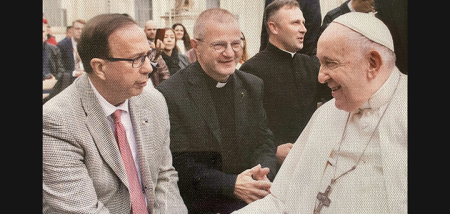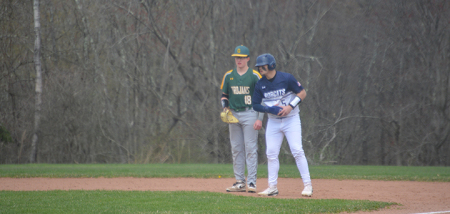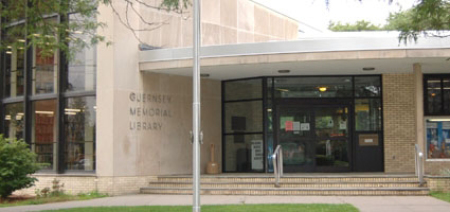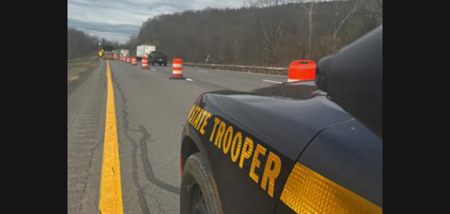Friends Of Rogers Powers Through Year Of Transition
Published:
February 5th, 2024
By:
Sarah Genter
 Friends of Rogers hit a major milestone this year at their annual First Day Hike on January 1. The event had its highest turnout ever with 110 participants. (Submitted photo)
Friends of Rogers hit a major milestone this year at their annual First Day Hike on January 1. The event had its highest turnout ever with 110 participants. (Submitted photo)
SHERBURNE — It’s been a busy and transitional year for the Friends of Rogers Environmental Education Center, but the organization has no intention of slowing down.
Friends of Rogers is a 501(c)(3) nonprofit organization that operates the 600 acres of land, five facilities, and seven miles of trails at the Rogers Center, located at 2721 State Route 80 in Sherburne. The organization is made up of 14 board members and a four-person staff who were all hired in the past year.
While bringing in all new staff members in one year was a significant transition for the organization, operations at the Rogers Center remained smooth, program offerings grew, and new community partnerships were formed.
A year of growth
Towards the end of 2022, Friends of Rogers bid farewell to Executive Director Simon Solomon and welcomed in David Carson as their new Executive Director.
Ellen Rathbone was also brought on as Senior Environmental Educator, and the organization hired Media and Marketing Coordinator Jeremy Fetzko and Bookkeeper and Administrative Assistant Amy August-Ruiz.
Although staff members agreed it was a challenging year as they were all new to the organization, their goal was to keep the same caliber of programming and service for the public.
“We convened as a team to remind one another that however challenging it felt to go through such a significant transition, that was only our experience of it,” said Carson. “The experience of the public was that there were new programs here, there was new staff here, there was new funding here, so it was really exciting.”
“Rogers Center is 120-odd years old. So translating that amount of institutional knowledge is just not going to happen quickly,” he added. “We are just the people that work here now. There are so many people who have worked here, and there will be so many people that work here in the future. Our names are just on the roster for this period in time. It’s our chance to do something with it.”
Despite any transitional challenges, the staff saw a year full of milestones and growth, including the launch of a community science project in collaboration with Colgate University through the Colgate Upstate Institute.
“We launched a community science program around pollinators that hopefully will be a multi-year project, and will bring a new era of scientific research to Rogers,” said Carson.
“Community science is the forefront of environmental science and community engagement. You essentially take a research question or a research project and then have a scientist or an educator devoted to cultivating community input,” he continued. “The community then gets involved by collecting the data, uploading it to a database that’s accessible by academic researchers, and then universities are able to use the data collected by individual citizens from the public to conduct large-scale research.”
The Bird Cabin at Rogers Center, which Carson calls a “high class mini museum” of taxidermied birds, received a floor-to-ceiling renovation by the Department of Environmental Conservation (DEC) in 2023. The new cabin was revealed to the public at the 2024 Winter Living Celebration scheduled for February 3.
The addition of Rathbone to the staff also allowed for the addition of several new programs at the Rogers Center.
In 2023, Rathbone started the Monday Morning Rambles, which is a weekly hike around areas of the Rogers Center property as well as occasional trips to nearby hiking locations. She also began Three Things Thursday, a summer adult education program that brings guest speakers to Rogers.
“This was really one of the best things that Ellen [Rathbone] did last year, was to bring a whole suite of adult education programs,” said Carson. “Three Things Thursday happens on the third Thursday of every month in the summer, and it brings in high-caliber guest speakers to talk about a specific subject, whether that’s fishing in Chenango County, or deer overabundance and its impact on the ecosystem, or people who are obsessed with mushrooms and want to learn all about fungus and their role.”
She also began equinox trivia nights, held on the two solstices and equinoxes each year, as well as several one-time educational programs.
In January, Friends of Rogers held a tracking workshop hosted by Rathbone, which taught attendees how to identify what animal left specific tracks and how to determine their gait, identifying animal scat, and identifying various other environmental signs left by animals.
In April, Rathbone led a workshop on phenology, which is the practice of tracking the seasonal changes of the natural world. Attendees learned why tracking local phenology is important to environmental science, how to use the nature tracking app iNaturalist, and the practice of nature journaling.
“You go out with your notebook and you record your observations of nature. Some people are writers and they write an awful lot. So, ‘I’m out here today and I see, oh gosh, there’s a little critter moving underneath the feeders, and I’m looking at it and, oh, it looks like this, and it sounds like that, and I believe it’s a short tailed shrew,’ and just start recording their observations,” Rathbone explained.
“Other people are artists, or like to sketch, and so they put a lot of illustrations in their journals. The ideal mix is to have a little bit of both,” she continued. “You’re recording in a notebook the things you are exposed to there out in nature. Some people like to bring in quotes, others are very philosophical about it, some people are very clinical about it and just list what they saw that day.”
Other workshops and programs at Friends of Rogers included Snow Science, Maple Magic, Spring Wildflower Walkabout, Mid-Morning Bird Walk, Native Bees Seek and Find, and many more.
In the fall, Friends of Rogers partnered with the Sherburne Inn to host the first Rogers Fall Festival fundraiser on October 14, which Fetzko said was a big milestone for the organization.
The event included dancing to music by Big Band Sounds, delicious hors d’oeuvres, and a silent auction. Attendees were also able to enjoy the building restorations made to the historic Sherburne Inn.
October also brought along the launch of Rogers’ artist residency in the Stone House, a historic structure built on the Rogers Center property in 1835 using stones dug from the Chenango Canal.
“It was the original foreman’s house when this was a game farm, and then it became the director’s residence when it became an education center,” Carson said. “Now it houses the interns in the summer and for the other ten months of the year we are turning it into an artists’ residency to bring artists here to learn about environmental science and translate environmental studies to the general public.”
The program was funded by the Statewide Community Regrants Program and administered by The Earlville Opera House, and all supplies were donated by Golden Artist Colors. The residency will culminate in an open house art show on April 20, just in time for Earth Day.
“[Golden] supplied us with all of the paint we needed for our artists this year. They are the premiere paint maker in the world, and they just happen to be located in upstate New York,” said Carson. “Having them as an advocate for this pilot project is pretty big. They have a mature and world-renowned residency program, so if we can be like them that would be great.”
In a testament to their dedication and ingenuity, the Rogers Center staff also spent 2023 creating a new website – a task that was completely new to them.
“Our last website was managed by a third party provider that kind of disappeared and put us in just an annoying operational inefficiency. So it took longer because none of us are web designers, but we were able to ultimately design our own website, so now we know exactly how it works,” Carson explained.
Friends of Rogers embraced change in the past year and were able to adapt and grow from it. Part of their success in 2023 was due to their partnerships with other organizations, which Carson says they hope to continue to cultivate in the future.
Powered by partnership
“In 2024, what I would like to see is leaning into this idea of powered by partnership,” said Carson.
Friends of Rogers has plenty of history partnering with other organizations, but Carson said he wants to expand that area of Rogers to offer even more educational opportunities, as well as opportunities to further environmental science efforts and connect with native cultures.
One of the ways to accomplish this goal is by continuing past collaborations with schools, organizations, and foundations.
Rogers has partnered with local school districts for many years, and Carson said this year they reached an unprecedented amount of schools and students. They also partner with several area colleges for programs and internship opportunities, including SUNY ESF, SUNY Morrisville, SUNY Cobleskill, and Colgate University.
“We’re a small team. It’s 600 acres and five facilities. For us to activate this place requires meaningful and regular partnerships, and so I’d love to see us grow tighter with Cornell Cooperative Extension, Colgate University, SUNY ESF, SUNY Morrisville,” Carson said. “Universities that have a budget and have students that can use Rogers as the laboratory. I would imagine we’ll see some of that take shape this year as well.”
Rogers has also received consistent support from local foundations over the years, which allows them to provide many of their programs to the community for free.
“We have a solid base of local philanthropic foundations. The Follett Foundation, the Greater Norwich Foundation, the Brown Charitable Trust, the Mabey Foundation, the Cook Foundation. These are all multi-generational wealth that intentionally stayed in the area through the creation of foundations,” said Carson. “That’s how we can offer our programs for free, because they are supported by these philanthropic organizations, and we do have a nice core here in this region.”
Friends of Rogers’ relationship with the Bullthistle Hiking Club was renewed this year at the annual First Day Hike. The event was first created by the DEC around 20 years ago, and environmental centers and organizations across the state participate every year.
Rogers joined the tradition approximately eight years ago, and just a few weeks ago they saw their highest attendance with 110 participants – a significant increase from 30 participants in 2023. Carson said they were able to handle the unexpectedly high numbers thanks to help from the Bullthistle Hiking Club, who helped lead the four groups of hikers around different areas of Rogers Center.
Moving forward, Carson hopes to not only continue these partnerships, but forge new ones, and there are already collaborations and projects in the works for 2024.
In the coming year, Friends of Rogers will be partnering with the Chenango County Historical Society to relocate their “Sugar Shack” to Rogers Center, where they can provide maple sugaring demonstrations and programs. They will also launch a pollinator habitat restoration project at Adam’s Farm in partnership with the Soil and Water Conservation District.
“It’s like 120 acres that we haven’t really used much in the last 60 years, and so the Soil and Water Conservation District has funded a community grant for us to take one of the fallow fields and restore pollinator habitats at about a two-acre scale. It should be fun,” said Carson.
He said bringing awareness to pollinators is hugely important, as the earth is seeing its sixth major extinction event, which could have devastating consequences for the environment.
“We are losing species at a rate faster than anything we’ve ever seen since the last extinction, and so projects like these bring attention to the fact that it’s a food desert out there for pollinators. The cascading effects that it has on an ecosystem are real and terrifying, and there’s something that we can do,” he said. “Even if it’s just a two-acre scale, it’s a chance to take a concise project and start to push the needle in the other direction.”
Friends of Rogers will also work to strengthen new partnerships forged in the past year, one of which is a partnership with the Oneida Indian Nation, which first took shape in 2023.
Carson said they hosted two educational programs titled “Legends and Lore of the Haudenosaunee,” which was the most well-attended public program offered by Friends of Rogers last year.
“A lot of it was narrative storytelling using animals as the protagonists. So, how the bear lost its tail. What’s the significance of the turtle in Native American culture, or at least for this region? Stories about the three sisters: squash, beans, and corn. Essentially translating the value systems and histories of the native peoples of this area through animals and plants and trees and things like that,” said Carson.
Due to the extremely good reception, Carson said he hopes to continue building a relationship with the Oneida Indian Nation to bring even more cultural programming to Rogers Center.
“It was very well received, and while we don’t know what our partnership will look like next year, that will open us up to a whole new world of knowledge and understanding another demographic,” said Carson.
Future development
After an exciting year of new developments, Carson said a large part of their goals in 2024 is exploring what programs and offerings were best received by the community, and how they can be integrated with one another.
“A lot of this new stuff that we have tried with all of us being new and some fresh ideas coming in here, we essentially gave ourselves the liberty to try new things and see what stuck, and now that we have found the things that the public has been the most receptive to, our task is now to figure out how they all work with one another,” Carson explained. “How does the Stone House residency intersect with the arts program and our school program that we do here at the center? How does the pollinator habitat work at Adam’s Farm integrate with school field trips? So how do we take these new ideas that have come to light and tie them together?”
Carson said they will also be working to “intentionally cultivate and increase the diversity of the audience that we serve” by hiring a community engagement coordinator, thanks to a grant provided by the New York State Office of Parks, Recreation, and Historic Preservation.
He said the community engagement coordinator’s responsibility would be to further Rogers Center’s role in community science through more public participation projects, as well as launching a youth advisory council.
“The youngest people on the planet will be those that inherit the consequences of our environmental actions. So putting together a youth advisory committee where we have like 15 to 18 year olds, or 14 to 18 year olds, involved in coming up with programming and helping to steer the direction of this organization would be something pretty novel and fun,” said Carson.
Having a youth advisory council would help Rogers to see what today’s youth are interested in and what kinds of programs they can offer to spark an interest in the environment among young people.
Carson asked, “What do you want? What kinds of programs do you want to see at Rogers? How do you want to be engaged?”
“Creating a space for them to help dictate what happens here would be really neat,” he said.
Furthering the knowledge and skills of staff members is another key element of Friends of Rogers’ plans to grow in the new year. Carson said all employees are provided a professional development stipend to take classes and workshops related to their jobs and interests.
Fetzko said this year he’ll be looking for online and digital marketing courses, and potentially some courses on fundraising. Carson said he will be working on his Spanish skills, and Rathbone will be taking a class on primitive skills such as fire starting, knot tying, and wilderness survival.
Of course, as an educational center, Friends of Rogers will also continue to educate the community about the environment. This will be done through programs and workshops as well as their internship program.
There are three internships offered at Rogers: environmental education, summer camp, and development. Environmental education interns help teach school programming; summer camp interns help to run the Rogers summer camp; and the development internship is for students on the business administration or finance career track who want to learn about environmental science or how to run a nature center.
Carson stressed that although internships are traditionally for college students, the internship opportunities at Rogers are also open to non-students who have experience working in environmental, educational, or child care and youth fields.
“I do want to make sure we are opening up these opportunities to people with lived experience and not just academic experience. You don’t have to go to college, you don’t have to be on the college track, to work here or to get an internship here,” he said.
“There’s a lot of intelligence you can gain outside of a college classroom … Someone who’s worked in this field in some capacity, someone who’s been a caretaker for young children for a while and it’s been paid or unpaid labor but they have this wealth of experience in dealing with and teaching and guiding kids. This could be a good opportunity to move into this field.”
To educate the community at large, Rogers Center will continue to offer various programs, and have even begun to introduce new ones. For example, Rathbone is beginning a quarterly book club this year, which will spend three months at a time reading and discussing a book, and closing out the quarter with a field trip to a location related to the book.
During the first quarter they’ll be reading “Eager: The Secret Life of Beavers and Why They Matter” by Ben Goldfarb. There will be a book club meeting at the end of January and February, both in person and virtually, to discuss the book. Then in March they will take a trip to Beaversprite, a nature preserve for beavers in Dolgeville.
Most of the programs at Rogers Center are free to attend or participate, but some cost a small fee. Moving forward, Carson said they may explore making all programs free, with the option to donate, to make their programs even more accessible to the community.
“It also keeps us in line with that, you don’t have to have anything to come here, and you don’t have to pay anything to come here. And so if you want to come and you can’t afford to pay, you don’t have to pay. But if you do come and you can afford to pay, consider paying for you and that someone else that can’t afford to pay,” said Carson.
“I know that people talk about the economic vitality of this region as a challenge, and it is, there’s no doubt that at large it is a challenge. But Rogers is free. It’s free to come here, kids get to come to programs through the school, our public programs are largely free,” he added. “The DEC owns the buildings and grounds still, so major capital projects are taken care of by New York State, which allows us to keep things really affordable. So I know economic vitality is a challenge, but it suits us well because we’re able to provide this service to anyone.”
The Friends of Rogers Environmental Education Center Visitor Center is open to the public from 10 a.m. to 4 p.m. Wednesday to Saturday, from noon to 4 p.m. on Sunday, and Monday and Tuesday by appointment.
For more information on Friends of Rogers, visit FriendsofRogers.org or the Friends of Rogers Environmental Education Center, Inc. Facebook page, or call 607-674-4733.
Author: Sarah Genter - More From This Author
Comments







